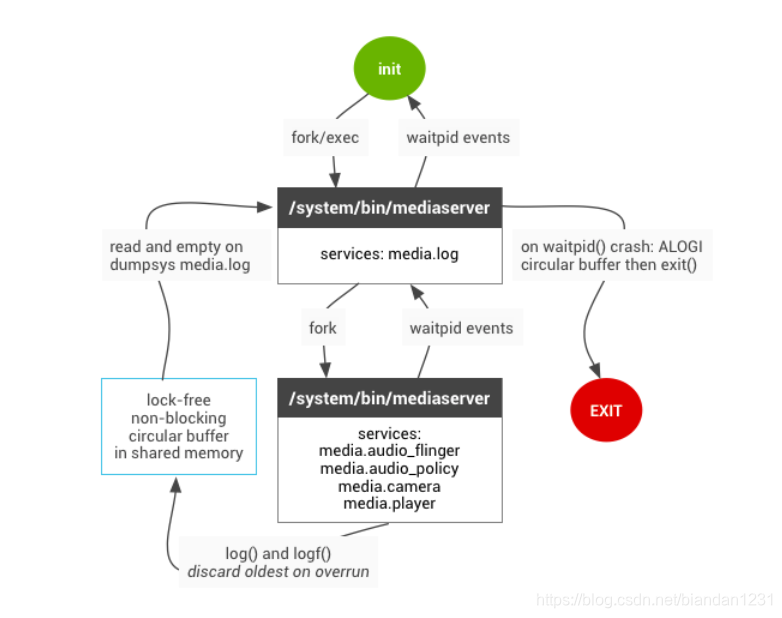AudioFlinger和AudioPolicy两者是Android Audio框架层最主要的两个服务,他们两个是Android框架层的本地服务,在init.rc中启动; 1、通过init进程fork出来,从而开始各自服务的初始化 1、通过init进程fork出来,从而开始各自服务的初始化 可以看到audioserver属于core类型,优于一般的main类型,也就是说它的启动是更早的。 2、首先初始化audioflinger服务 audiopolicyservice启动后,开始创建audiopolicymanager,并通过audiopolicymanager初始化audiopolicy策略,然后再进行对audio路由引擎(EngineInstance)进行初始化,初始化完路由引擎后便对audio hal 的so进行加载初始化,进一步通过加载后的so针对音频设备进行open操作,并默认打开主通道的输出音频流,最后将成功初始化的音频设备进行保存到audiopolicymanager以及audioflinger中,最后完成初始化。 从上面的初始大概流程可以知道,audio框架的初始化重点在audiopolicy部分的初始化,它不仅需要初始音频策略,还需针对加载的音频策略针对hal层的音频设备进行初始化,这部分还涉及到audioflinger部分,但以audiopolicy作为主线进行分析,下面将一步步对其进行分析。 可以看到AudioPolicyManager构造函数很简单,就两个调用: 下面进入详细分析: 很简单,就通过配置文件USE_XML_AUDIO_POLICY_CONF来控制是使用XML配置的策略文件还是使用传统旧config配置文件。这个变量的初始化可以通过配置文件进行选择。 1.1这个getConfig()得到的mConfig成员变量如下: 这些成员变量在解析配置文件(XML格式或者config格式)会得到初始化,这点很重要,后续的so加载会根据配置的module name来进行加载。其会通过Serializer.cpp进行XML文件的解析,这个是一个很繁重的任务,如需讲明其解析过程还需另起一个篇幅才能将其介绍,与初始化关系不大,一笔带过。 好了,上面的都是开胃菜,这个才是硬菜。 好了,是不是也挺简单的,就三步。 2.1.1 创建路由 loadHwModule(hwModule->getName()); 到这里,音频设备打开就完毕了; 到了AudioPolicyClientInterface 这个就明朗了,调用如下: 小结:
AudioPolicy&AudioFlinger初始化
总体框架
AudioPolicyManager负责音频策略定制者,说白了就相当于Audio系统的司令。
AudioFlinger负责与底层audio alsa进行交互的实现者,那么它就是Audio系统的军官,干苦力的;
总体框架:
两个服务都属于audioserver进程,严格意义上来说audioserver通过init进程fork出来的,所以它是Linux系统中的一个进程。
AudioFlinger:media.audio_flinger
AudioPolicyService:media.audio_policy

初始化步骤简介
2、首先初始化audioflinger服务
3、其次初始化audiopolicyservice服务
4、进一步通过audiopolicyservice和audioflinger完成音频hal层的初始化,这部分将是本文的重点难点分析。
来,看下它是怎么定义://frameworks/av/media/audioserver/audioserver.rc service audioserver /system/bin/audioserver class core user audioserver onrestart restart audio-hal-2-0 ioprio rt 4 //设置io优先级 disabled
audioflinger&audiopolicyserver启动:frameworks/av/media/audioserver/main_audioserver.cpp int main(int argc __unused, char **argv) { --- android::hardware::configureRpcThreadpool(4, false /*callerWillJoin*/); sp<ProcessState> proc(ProcessState::self()); sp<IServiceManager> sm = defaultServiceManager(); ALOGI("ServiceManager: %p", sm.get()); AudioFlinger::instantiate(); AudioPolicyService::instantiate(); --- }
AudioFlinger初始化比较简洁,就是创建服务并将自身注册到systemserver中去,其次就是初始化部分通信组件以便后续与audio hal层进行通讯。如下图所示:

3、其次初始化audiopolicyservice服务
AudioPolicyService的初始化就比audioflinger服务初始化复杂了,下图仅仅是audiopolicyservice与audiopolicymanager的初始化。主要就是创建出几个线程(AudioCommandThread类型的线程),以便后续与上层进行交互使用,上层调用的比如播放暂停的操作指令会进入这个线程队列,实现上层异步调用也可以防止底层耗时操作导致阻塞上层应用。接着便是创建AudioPolicyManager实例以及客户端等。大概流程如下图所示:

4、进一步通过audiopolicyservice和audioflinger完成音频hal层的初始化,这部分将是本文的重点难点分析。
详细的初始化流程如下图所示:

初始化步骤详细流程分析
//frameworks/av/services/audiopolicy/managerdefault/AudioPolicyManager.cpp AudioPolicyManager::AudioPolicyManager(AudioPolicyClientInterface *clientInterface) : AudioPolicyManager(clientInterface, false /*forTesting*/) { //1、加载audiopolicy的策略文件 loadConfig(); //2、针对加载的策略进行真正的初始化 initialize(); }
第一步:loadConfig()
第二步:initialize()1、loadConfig()
//frameworks/av/services/audiopolicy/managerdefault/AudioPolicyManager.cpp void AudioPolicyManager::loadConfig() { #ifdef USE_XML_AUDIO_POLICY_CONF //getConfig()这个很重要,为了后续的加载so做准备 if (deserializeAudioPolicyXmlConfig(getConfig()) != NO_ERROR) { #else if ((ConfigParsingUtils::loadConfig(AUDIO_POLICY_VENDOR_CONFIG_FILE, getConfig()) != NO_ERROR) && (ConfigParsingUtils::loadConfig(AUDIO_POLICY_CONFIG_FILE, getConfig()) != NO_ERROR)) { #endif ALOGE("could not load audio policy configuration file, setting defaults"); getConfig().setDefault(); } } mConfig(mHwModulesAll, mAvailableOutputDevices, mAvailableInputDevices, mDefaultOutputDevice, static_cast<VolumeCurvesCollection*>(mVolumeCurves.get()))
XML的配置文件格式如下(简化版配置,这块涉及到音频路由,后续将会再写一篇详细介绍该配置文件)://frameworks/av/services/audiopolicy/config/audio_policy_configuration.xml <audioPolicyConfiguration version="1.0" xmlns:xi="https://www.w3.org/2001/XInclude"> <globalConfiguration speaker_drc_enabled="true"/> <modules> //编译后生成的so命名会根据module name 以及soc名字生成e.g. audio.[module name].[soc name] //如IMX8的:audio.primary.imx8.so <module name="primary" halVersion="2.0"> <attachedDevices> <item>Speaker</item> </attachedDevices> <defaultOutputDevice>Speaker</defaultOutputDevice> <mixPorts>//输出混音线程 <mixPort name="primary output" role="source" flags="AUDIO_OUTPUT_FLAG_PRIMARY"> <profile name="" format="AUDIO_FORMAT_PCM_16_BIT" samplingRates="48000" channelMasks="AUDIO_CHANNEL_OUT_STEREO"/> </mixPort> </mixPorts> <devicePorts>//输出设备节点 <devicePort tagName="Speaker" type="AUDIO_DEVICE_OUT_SPEAKER" role="sink" > </devicePort> </devicePorts> <routes> //音频路由 <route type="mix" sink="Speaker" sources="esai output,primary output"/> </routes> </module> </modules> </audioPolicyConfiguration> 2、initialize()
来,看下这个大概步骤,心中有谱,码海不慌。
主要是三个步骤:
2.1初始音频路由引擎
audio_policy::EngineInstance *engineInstance = audio_policy::EngineInstance::getInstance();
2.2、加载so 并且打开设备节点
mpClientInterface->loadHwModule(hwModule->getName())
2.3、打开输出流
status_t status = outputDesc->open(nullptr, profileType, address, AUDIO_STREAM_DEFAULT, AUDIO_OUTPUT_FLAG_NONE,&output);
怕你不信,所以贴了部分代码出来://frameworks/av/services/audiopolicy/managerdefault/AudioPolicyManager.cpp status_t AudioPolicyManager::initialize() { //1、初始音频路由引擎 // Once policy config has been parsed, retrieve an instance of the engine and initialize it. audio_policy::EngineInstance *engineInstance = audio_policy::EngineInstance::getInstance(); if (!engineInstance) { ALOGE("%s: Could not get an instance of policy engine", __FUNCTION__); return NO_INIT; } // Retrieve the Policy Manager Interface mEngine = engineInstance->queryInterface<AudioPolicyManagerInterface>(); if (mEngine == NULL) { ALOGE("%s: Failed to get Policy Engine Interface", __FUNCTION__); return NO_INIT; } mEngine->setObserver(this); status_t status = mEngine->initCheck(); for (const auto& hwModule : mHwModulesAll) { //2、加载so 并且打开设备节点 hwModule->setHandle(mpClientInterface->loadHwModule(hwModule->getName())); mHwModules.push_back(hwModule); // open all output streams needed to access attached devices // except for direct output streams that are only opened when they are actually // required by an app. // This also validates mAvailableOutputDevices list for (const auto& outProfile : hwModule->getOutputProfiles()) { //经过一系列有效判断后 创建输出相关参数 sp<SwAudioOutputDescriptor> outputDesc = new SwAudioOutputDescriptor(outProfile, mpClientInterface); const DeviceVector &supportedDevices = outProfile->getSupportedDevices(); const DeviceVector &devicesForType = supportedDevices.getDevicesFromType(profileType); String8 address = devicesForType.size() > 0 ? devicesForType.itemAt(0)->mAddress : String8(""); audio_io_handle_t output = AUDIO_IO_HANDLE_NONE; //3、打开输出流 status_t status = outputDesc->open(nullptr, profileType, address, AUDIO_STREAM_DEFAULT, AUDIO_OUTPUT_FLAG_NONE, &output); if (status != NO_ERROR) { ALOGW("Cannot open output stream for device %08x on hw module %s", outputDesc->mDevice, hwModule->getName()); } else { for (const auto& dev : supportedDevices) { ssize_t index = mAvailableOutputDevices.indexOf(dev); // give a valid ID to an attached device once confirmed it is reachable if (index >= 0 && !mAvailableOutputDevices[index]->isAttached()) { //这个很重要的变量,保存了可用的输出设备,后续会进一步说明 mAvailableOutputDevices[index]->attach(hwModule); } } if (mPrimaryOutput == 0 && outProfile->getFlags() & AUDIO_OUTPUT_FLAG_PRIMARY) { mPrimaryOutput = outputDesc; } addOutput(output, outputDesc); setOutputDevice(outputDesc, profileType, true, 0, NULL, address); } }//end inner for }//end out for } // make sure all attached devices have been allocated a unique ID 2.1、初始音频路由引擎
audio_policy::EngineInstance
这块有可配置路由和默认路由之分,音频流是根据路由策略进行打开相应的音频路由通路的。这部分内容需要领开一篇进行分析。这是一块很重要的内容,这里暂不展开分析。2.2、加载so 并且打开设备节点
参数是由上面步骤初始配置文件得到,hwModule->getName():如IMX8的根据配置文件:audio.primary.imx8.so
会在vendor/lib/hw/加载文件,如果找不到会依次在system/lib/hw/进行查找。
详细步骤如下://注意这个返回值是audio_module_handle_t,这是个线程,这个很重要 //因为后续的播放录音Track都是挂到这个audio_module_handle_t上去的,这个是个线程 //frameworks/av/services/audioflinger/AudioFlinger.cpp audio_module_handle_t AudioFlinger::loadHwModule(const char *name){ 1==>进一步调用loadHwModule_l(name); 2====> 再进一步调用到DevicesFactoryHal的openDevice方法打开驱动设备 //frameworks/av/services/audioflinger/AudioFlinger.cpp int rc = mDevicesFactoryHal->openDevice(name, &dev); 3=======>调用本地通讯方式的DeviceFactroy实现 //frameworksavmedialibaudiohal2.0DevicesFactoryHalLocal.cpp status_t DevicesFactoryHalLocal::openDevice(const char *name, sp<DeviceHalInterface> *device) 3.1=======>继续调用到load_audio_interface //frameworksavmedialibaudiohal2.0DevicesFactoryHalLocal.cpp static status_t load_audio_interface(const char *if_name, audio_hw_device_t **dev){ const hw_module_t *mod; int rc; rc = hw_get_module_by_class(AUDIO_HARDWARE_MODULE_ID, if_name, &mod); if (rc) { ALOGE("%s couldn't load audio hw module %s.%s (%s)", __func__, AUDIO_HARDWARE_MODULE_ID, if_name, strerror(-rc)); goto out; } rc = audio_hw_device_open(mod, dev); return rc; } 4=========>最终会调用到audio.h的方法open,audio_hw_device_open方法会调用设备的open方法 //hardware/libhardware/include/hardware/audio.h static inline int audio_hw_device_open(const struct hw_module_t* module, struct audio_hw_device** device){ return module->methods->open(module, AUDIO_HARDWARE_INTERFACE, TO_HW_DEVICE_T_OPEN(device)); } 5==========>最后会调用到 //最终会调用到各自厂商实现的hal层的open方法,代码路径就不放了 static int adev_open(const hw_module_t* module, const char* name, hw_device_t** device)
额外说明一下:mDevicesFactoryHal的初始化:1、 // mDevicesFactoryHal初始化是在AudioFlinger初始化的时候进行的: //frameworks/av/services/audioflinger/AudioFlinger.cpp mDevicesFactoryHal = DevicesFactoryHalInterface::create(); //frameworks/av/media/libaudiohal/DevicesFactoryHalInterface.cpp sp<DevicesFactoryHalInterface> DevicesFactoryHalInterface::create() { if (hardware::audio::V4_0::IDevicesFactory::getService() != nullptr) { return new V4_0::DevicesFactoryHalHybrid(); } if (hardware::audio::V2_0::IDevicesFactory::getService() != nullptr) { return new DevicesFactoryHalHybrid(); } return nullptr; } DevicesFactoryHalHybrid:Hybrid混合,包含了本地通讯方式,也包含了HIDL通讯方式: //frameworks/av/media/libaudiohal/impl/DevicesFactoryHalHybrid.cpp DevicesFactoryHalHybrid::DevicesFactoryHalHybrid(sp<IDevicesFactory> hidlFactory) : mLocalFactory(new DevicesFactoryHalLocal()), mHidlFactory(new DevicesFactoryHalHidl(hidlFactory)) { } status_t DevicesFactoryHalHybrid::openDevice(const char *name, sp<DeviceHalInterface> *device) { if (mHidlFactory != 0 && strcmp(AUDIO_HARDWARE_MODULE_ID_A2DP, name) != 0 && strcmp(AUDIO_HARDWARE_MODULE_ID_HEARING_AID, name) != 0) { return mHidlFactory->openDevice(name, device); } return mLocalFactory->openDevice(name, device); } 到这里,mDevicesFactoryHal的初始化介绍就完毕了。 但是Android 10以后是mDevicesFactoryHal的初始化是这样实现的: //frameworks/av/media/libaudiohal/DevicesFactoryHalInterface.cpp sp<DevicesFactoryHalInterface> DevicesFactoryHalInterface::create() { return createPreferredImpl<DevicesFactoryHalInterface>( "android.hardware.audio", "IDevicesFactory"); } 通过是从服务中根据名称"android.hardware.audio", "IDevicesFactory"获取的,暂不深究。 2.3、打开输出流
//frameworks/av/services/audiopolicy/managerdefault/AudioPolicyManager.cpp AudioPolicyManager::initialize() const DeviceVector &supportedDevices = outProfile->getSupportedDevices(); const DeviceVector &devicesForType = supportedDevices.getDevicesFromType(profileType); String8 address = devicesForType.size() > 0 ? devicesForType.itemAt(0)->mAddress : String8(""); audio_io_handle_t output = AUDIO_IO_HANDLE_NONE; status_t status = outputDesc->open(nullptr, profileType, address, AUDIO_STREAM_DEFAULT, AUDIO_OUTPUT_FLAG_NONE, &output); //frameworks/av/services/audiopolicy/common/managerdefinitions/src/AudioOutputDescriptor.cpp status_t SwAudioOutputDescriptor::open(const audio_config_t *config, const DeviceVector &devices, audio_stream_type_t stream, audio_output_flags_t flags, audio_io_handle_t *output) { mDevices = devices; sp<DeviceDescriptor> device = devices.getDeviceForOpening(); LOG_ALWAYS_FATAL_IF(device == nullptr, "%s failed to get device descriptor for opening " "with the requested devices, all device types: %s", __func__, dumpDeviceTypes(devices.types()).c_str()); audio_config_t lConfig; if (config == nullptr) { lConfig = AUDIO_CONFIG_INITIALIZER; lConfig.sample_rate = mSamplingRate; lConfig.channel_mask = mChannelMask; lConfig.format = mFormat; } else { lConfig = *config; } // if the selected profile is offloaded and no offload info was specified, // create a default one if ((mProfile->getFlags() & AUDIO_OUTPUT_FLAG_COMPRESS_OFFLOAD) && lConfig.offload_info.format == AUDIO_FORMAT_DEFAULT) { flags = (audio_output_flags_t)(flags | AUDIO_OUTPUT_FLAG_COMPRESS_OFFLOAD); lConfig.offload_info = AUDIO_INFO_INITIALIZER; lConfig.offload_info.sample_rate = lConfig.sample_rate; lConfig.offload_info.channel_mask = lConfig.channel_mask; lConfig.offload_info.format = lConfig.format; lConfig.offload_info.stream_type = stream; lConfig.offload_info.duration_us = -1; lConfig.offload_info.has_video = true; // conservative lConfig.offload_info.is_streaming = true; // likely } mFlags = (audio_output_flags_t)(mFlags | flags); ALOGV("opening output for device %s profile %p name %s", mDevices.toString().c_str(), mProfile.get(), mProfile->getName().c_str()); status_t status = mClientInterface->openOutput(mProfile->getModuleHandle(), output, &lConfig, device, &mLatency, mFlags); mClientInterface:是在AudioPolicyManager调用的时候传进去的 AudioPolicyClientInterface *mpClientInterface; // audio policy client interface

大概流程就是AudioPolicyManager–>AudioPolicyService–>AudioFlinger–>audio hal层了。至此,output 输出流打开成功。
最后将已经打开的输出流和输出设备保存到相应的数组里面,后续有流需要播出的时候直接进行查找,如果查找不到会尝试向底层查询,如果查询支持将会打开,如果查询不到,则会将其流类型改变并且将其加入到默认输出流里面进行播放处理。
这里的一切都是为音频播放做准备,后续将介绍音频路由部分。
本网页所有视频内容由 imoviebox边看边下-网页视频下载, iurlBox网页地址收藏管理器 下载并得到。
ImovieBox网页视频下载器 下载地址: ImovieBox网页视频下载器-最新版本下载
本文章由: imapbox邮箱云存储,邮箱网盘,ImageBox 图片批量下载器,网页图片批量下载专家,网页图片批量下载器,获取到文章图片,imoviebox网页视频批量下载器,下载视频内容,为您提供.
阅读和此文章类似的: 全球云计算
 官方软件产品操作指南 (170)
官方软件产品操作指南 (170)